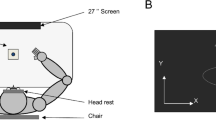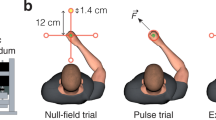Abstract
Bimanual coordination is an essential feature of the motor system, yet interactions between the limbs during independent control remain poorly understood. Interference between the two hands, or the assimilation of movement characteristics between the two effectors, can be induced by perturbing one arm (e.g., via visuomotor rotation) and then measuring the effects in the contralateral limb. In this study, we sought to further determine the role adaptation plays in bimanual interference using a structural learning paradigm to alter feedback regulation in reaching. We trained healthy participants to counter 60 unique random rotations in right hand visual feedback over 240 reaches. Following this, we assessed feedforward and feedback measures of interference in a bimanual reaching task where the right hand was exposed to a fixed visual feedback rotation while the left hand reached without visual feedback. We found that participants who had been exposed to the structural training task in the right hand showed increased left hand interference during the first 20 trials of the test task. Moreover, interference was greater in feedback, rather than feedforward control parameters. The results further suggest that structural learning enhances bimanual interference via sensory feedback upregulation.






Similar content being viewed by others
Data availability
The datasets generated during and/or analyzed during the current study are available from the corresponding author on reasonable request.
References
Bank PJM, Dobbe LRM, Meskers CGM, De Groot JH, De Vlugt E (2017) Manipulation of visual information affects control strategy during a visuomotor tracking task. Behav Brain Res 329:205–214. https://doi.org/10.1016/j.bbr.2017.04.056
Bingham GP, Romack JL (1999) The rate of adaptation to displacement prisms remains constant despite acquisition of rapid calibration. J Exp Psychol 25(5):1331–1346. https://doi.org/10.1037/0096-1523.25.5.1331
Bingham GP, Pan JS, Mon-Williams MA (2014) Calibration is both functional and anatomical. J Exp Psychol Hum Percept Perform 40(1):61–70. https://doi.org/10.1037/a0033458
Bond KM, Taylor JA (2017) Structural learning in a visuomotor adaptation task is explicitly accessible. Eneuro. https://doi.org/10.1523/ENEURO.0122-17.2017
Braun DA, Aertsen A, Wolpert DM, Mehring C (2009a) Learning optimal adaptation strategies in unpredictable motor tasks. J Neurosci 29(20):6472–6478
Braun DA, Aertsen A, Wolpert DM, Mehring C (2009b) Motor task variation induces structural learning. Curr Biol 19(4):352–357
Brunfeldt AT, Desrochers PC, Kagerer FA (2021) Bimanual interference increases with force demands and is facilitated by visuomotor adaptation. Neuroscience 463:57–69. https://doi.org/10.1016/j.neuroscience.2021.03.012
Brunfeldt AT, Desrochers PC, Kagerer FA (2023) Structural learning benefits in a visuomotor adaptation task generalize to a contralateral effector (in review)
Cunningham DA (2017) The effect of motor overflow on bimanual asymmetric force coordination. Exp Brain Res 0(0):0–0
Diedrichsen J (2007) Optimal task-dependent changes of bimanual feedback control and adaptation. Curr Biol CB 17(19):1675–1679
Franklin S, Wolpert DM, Franklin DW (2012) Visuomotor feedback gains upregulate during the learning of novel dynamics. J Neurophysiol 108(2):467–478
Franklin S, Wolpert DM, Franklin DW (2017) Rapid visuomotor feedback gains are tuned to the task dynamics. J Neurophysiol 118(5):2711–2726
Franz EA (1997) Spatial coupling in the coordination of complex actions. Quart J Exp Psychol Sect A 50(3):684–704. https://doi.org/10.1080/713755726
Franz EA, Eliassen JC, Ivry RB, Gazzaniga MS (1996) Dissociation of spatial and temporal coupling in the bimanual movements of callosotomy patients. Psychol Sci 7(5):306–310
Griffiths TL, Tenenbaum JB (2005) Structure and strength in causal induction. Cognit Psychol 51:334–384
Hughes CML, Franz EA (2008) Goal-related planning constraints in bimanual grasping and placing of objects. Exp Brain Res 188(4):541–550. https://doi.org/10.1007/s00221-008-1387-8
Kagerer FA (2015) Crossmodal interference in bimanual movements: effects of abrupt visuo-motor perturbation of one hand on the other. Exp Brain Res 233(3):839–849
Kagerer FA (2016) Nondominant-to-dominant hand interference in bimanual movements is facilitated by gradual visuomotor perturbation. Neuroscience 318(C):94–103
Kelso JA, Southard DL, Goodman D (1979) On the nature of human interlimb coordination. Science (new York, n.y.) 203(4384):1029–1031
Lotankar S, Prabhavalkar KS, Bhatt LK (2017) Biomarkers for Parkinson’s Disease: recent advancement. Neurosci Bull 33(5):585–597. https://doi.org/10.1007/s12264-017-0183-5
Magill R, Hall K (1990) A review of the contextual interference effect in motor skill acquisition. Hum Mov Sci 9(3–5):241–289
Mazzoni P, Krakauer JW (2006) An implicit plan overrides an explicit strategy during visuomotor adaptation. J Neurosci 26(14):3642–3645
Meyer B-U, Röricht S, von Einsiedel HG, Kruggel F, Weindl A (1995) Inhibitory and excitatory interhemispheric transfers between motor cortical areas in normal humans and patients with abnormalities of the corpus callosum. Brain 118(2):429–440. https://doi.org/10.1093/brain/118.2.429
Mon-Williams M, Bingham GP (2007) Calibrating reach distance to visual targets. J Exp Psychol Hum Percept Perform 33(3):645–656. https://doi.org/10.1037/0096-1523.33.3.645
Oldfield RC (1971) The assessment and analysis of handedness: the Edinburgh inventory. Neuropsychologia 9(1):97–113
Olejnik S, Algina J (2003) Generalized eta and omega squared statistics: measures of effect size for some common research designs. Psychol Methods 8(4):434–447. https://doi.org/10.1037/1082-989X.8.4.434
Perez MA, Cohen LG (2008) Mechanisms underlying functional changes in the primary motor cortex ipsilateral to an active hand. J Neurosci 28(22):5631–5640
Sainburg RL (2002) Evidence for a dynamic-dominance hypothesis of handedness. Exp Brain Res 142(2):241–258
Schmidt RA (1975) A schema theory of discrete motor skill learning. Psychol Rev 82(4):225–260. https://doi.org/10.1037/h0076770
Schwartz AB (2016) Movement: how the brain communicates with the world. Cell 164(6):1122–1135
Scott SH (2004) Optimal feedback control and the neural basis of volitional motor control. Nat Rev Neurosci 5(7):532–546
Shea JB, Morgan RL (1979) Contextual interference effects on the acquisition, retention, and transfer of a motor skill. J Exp Psychol Hum Learn Memeory 5(2):179–187. https://doi.org/10.1037/0278-7393.5.2.179
Sherwood DE (1991) Distance and location assimilation effects in rapid bimanual movement. Res Q Exerc Sport 62(3):302–308. https://doi.org/10.1080/02701367.1991.10608727
Stedman A, Davey NJ, Ellaway PH (1998) Facilitation of human first dorsal interosseous muscle responses to transcranial magnetic stimulation during voluntary contraction of the contralateral homonymous muscle. Muscle Nerve 7:1033–1039
Swinnen SP (2002) Intermanual coordination: from behavioural principles to neural-network interactions. Nat Rev Neurosci 3(5):348–359
Taylor JA, Krakauer JW, Ivry RB (2014) Explicit and implicit contributions to learning in a sensorimotor adaptation task. J Neurosci 34(8):3023–3032
Todorov E (2004) Optimality principles in sensorimotor control. Nat Neurosci 7(9):907–915
Todorov E, Jordan MI (2002) Optimal feedback control as a theory of motor coordination. Nat Neurosci 5(11):1226–1235
Uhlarik JJ (1973) Role of cognitive factors on adaptation to prismatic displacement. J Exp Psychol 98(2):223–232. https://doi.org/10.1037/h0034364
Veale JF (2013) Edinburgh Handedness Inventory—Short Form: a revised version based on confirmatory factor analysis. Laterality Asymmetries Body Brain Cognit 19(2):164–177. https://doi.org/10.1080/1357650X.2013.783045
Walter CB, Swinnen SP (1990) Asymmetric interlimb interference during the performance of a dynamic bimanual task. Brain Cogn 14(2):185–200
Welch RB (1978) Perceptual modification—adapting to altered sensory environments. Academic Press, INC., New York
Yousif N, Diedrichsen J (2012) Structural learning in feedforward and feedback control. J Neurophysiol 108(9):2373–2382
Zarahn E, Weston GD, Liang J, Mazzoni P, Krakauer JW (2008) Explaining savings for visuomotor adaptation: linear time-invariant state-space models are not sufficient. J Neurophysiol 100(5):2537–2548. https://doi.org/10.1152/jn.90529.2008
Author information
Authors and Affiliations
Contributions
AB, PD, and FK initiated and designed the study. AB collected and analyzed the data. AB, PD, and FK interpreted the results. AB wrote the manuscript with meaningful editorial contributions from FK. All authors read and approved the final manuscript.
Corresponding author
Ethics declarations
Conflict of interest
All authors disclose no competing interests, financial or otherwise.
Ethical approval
All study procedures were approved by the corresponding author’s University Institutional Review Board and all participants gave informed consent.
Additional information
Communicated by Melvyn A. Goodale.
Publisher's Note
Springer Nature remains neutral with regard to jurisdictional claims in published maps and institutional affiliations.
Rights and permissions
Springer Nature or its licensor (e.g. a society or other partner) holds exclusive rights to this article under a publishing agreement with the author(s) or other rightsholder(s); author self-archiving of the accepted manuscript version of this article is solely governed by the terms of such publishing agreement and applicable law.
About this article
Cite this article
Brunfeldt, A.T., Desrochers, P.C. & Kagerer, F.A. Facilitated adaptation via structural learning increases bimanual interference. Exp Brain Res 242, 137–148 (2024). https://doi.org/10.1007/s00221-023-06732-4
Received:
Accepted:
Published:
Issue Date:
DOI: https://doi.org/10.1007/s00221-023-06732-4




